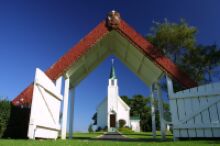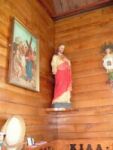
The church was built before road
construction came to the Te Puna district and the rivers had to be forded
and swum. Pirirakau residents trecked to Whakamarama for building timber
and felled rimu trees 4 and 5 ft diameter. The logs pit sawn to reduce
them to manageable dimensions.
With no wagons or roads, the only alternative was to use horses to drag
the timber from the bush down to the head of the Te Puna River. Here the
sawn logs were assembled into rafts and workers then poled them down-river
with the outgoing tide and slowly and laboriously brought them down the
harbour to the Te Puna sea front where they were dragged to the site and
the building of St Joseph's Church was able to begin.
The construction was undertaken by Werehiko Borell and Hone Bidois.
Puriri blocks of almost strainer length were first, put in the ground at
each corner of the building with shorter lengths between. The floor
framing was amade of heart rimu. The wall framing, roof beams were made of
heart wood and of heavy dimension and hand dressed. The interior lining,
pit sawn rewa-rewa with a beautiful grain was hand dressed and varnished
until "Poutu-Terangi" (the Pillar that stands from the Earth to
Heaven)opened in January 1st 1900, a symbol of faith and
hope.
Written by Mr David Borell, J.P.
A meeting house was also built and this
was used to accommodate the congregation who attended the opening.



St Josephs, the Spiritual Church of the Roman Catholic Faith, Te Puna.
Click on photos to enlarge
       
|